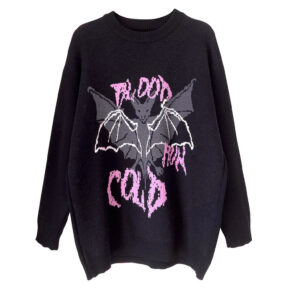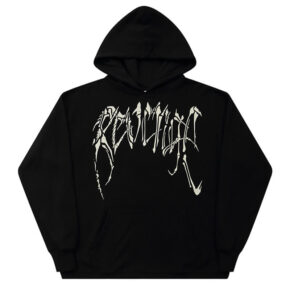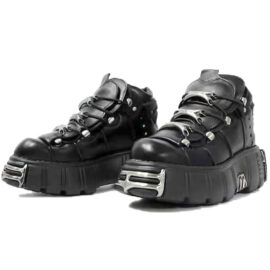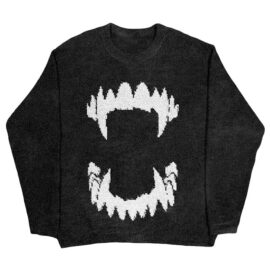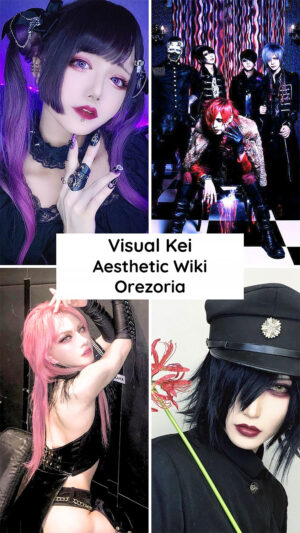
Visual Kei is a unique aesthetic movement that originated in the Japanese music scene in the 1980s. Unlike other musical genres, Visual Kei places equal importance on the visual aspects of a band as it does on their music. This emphasis on visual aesthetics makes Visual Kei stand out as a distinct and iconic style.
Visual Kei combines elements of Western glam rock, punk, and gothic with a uniquely Japanese aesthetic. One of the defining features of Visual Kei is the heavy use of makeup, with bands and artists experimenting with dark eyeliner, vivid lip colors, and exaggerated shapes.
Another key element of the Visual Kei aesthetic is the androgynous fashion. Male band members often sport wild hair, spiky hair, or intricate hair clips, while female members enhance their femininity with outrageous outfits and accessories.
The impact of Visual Kei extends beyond the music world. It has greatly influenced the fashion and art industries, as well as pop culture in Japan. Visual Kei has become synonymous with the Japanese fashion movement, inspiring countless fashion trends and statements. Its influence can also be seen in music videos and performances by mainstream bands, with artists like David Bowie drawing inspiration from this unique aesthetic.
Related aesthetics: 2K Animecore, Y2K, Acubi, Addamscore, Aespacore, Alternative, Animecore, Cyber Y2K, Dark Fashion, Doomer, E-Girl, Edgy, Emo, Goth, Grunge, Harajuku, J-Rock, Mallgoth, Punk, Vampire, Witchcore, Yandere
Full List of Aesthetics
History of the Visual Kei Aesthetic
The Visual Kei aesthetic traces its roots back to the 1980s underground music scene in Tokyo, Japan. Fusing Western glam rock, punk, and gothic influences with a uniquely Japanese aesthetic, Visual Kei emerged as a powerful expression of individuality and creativity.
At its core, Visual Kei was not just about the music, but about pushing boundaries and defying societal norms. In the colorful and eclectic neighborhood of Harajuku, bands like X Japan paved the way for this new movement. With their extravagant costumes, wild hairstyles, and captivating performances, they captured the essence of Visual Kei.
Visual Kei quickly became more than just a fashion statement; it became a form of artistic expression. Bands and artists used their music and visual aesthetics to challenge conventions and explore new possibilities. The heavy use of makeup, dramatic hairstyles, and eye-catching outfits allowed them to create fantastical and theatrical personas.
Through its energetic and flamboyant performances, Visual Kei captivated audiences and gained a devoted following. It also influenced other aspects of Japanese pop culture, from fashion to art. What started as an underground movement soon spread, influencing not only the Japanese music scene, but also inspiring artists and musicians around the world.
Today, the legacy of Visual Kei lives on, with its impact apparent in the wide variety of musical genres and fashion styles that continue to be influenced by its bold and unique aesthetic.
Key Elements of the Visual Kei Aesthetic
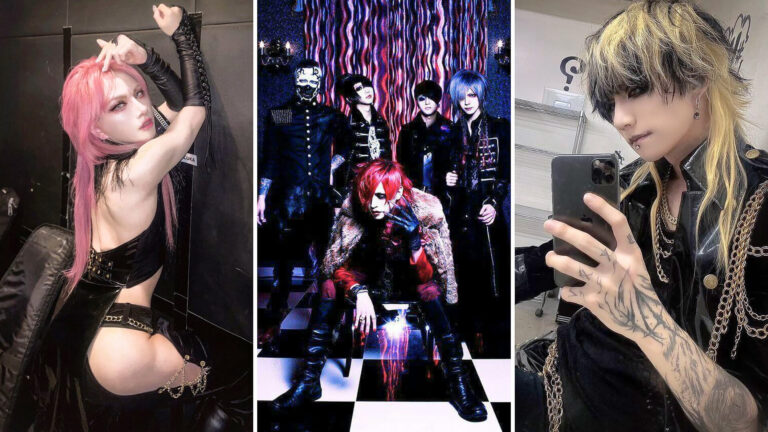
The Visual Kei aesthetic is characterized by several key elements that make it stand out and distinguish it from other styles and genres. One of the most prominent aspects of Visual Kei is the bold makeup that artists and bands wear. Heavy eyeliner, vibrant eyeshadows, and bold lipstick are commonly used to create extravagant and captivating looks.
Another essential component of the Visual Kei aesthetic is the dramatic and elaborate hairstyles. Artists often sport wild and intricate styles, with spiky hair, brightly colored or multi-toned hair, and various hair accessories such as hair clips and extensions. These hairstyles contribute to the overall visual impact of the performers and their music.
Visual Kei also embraces mixed clothing styles that combine elements from different fashion genres and eras. From glam rock to punk influences, Visual Kei artists experiment with a wide range of clothing, including leather jackets, corsets, lace, and platform boots. This eclectic mix of styles adds to the uniqueness and individuality of the Visual Kei look.
Ostentatious accessories, such as large and elaborate jewelry, belts, and scarves, are another important element of the Visual Kei aesthetic. These accessories help create a visually striking appearance and enhance the overall flamboyance and theatricality of the performers.
In addition, Visual Kei often incorporates traditional Japanese motifs into its aesthetic, blending elements of Japanese culture with Western influences. This fusion results in an intriguing combination of traditional and contemporary styles, adding depth and richness to the Visual Kei look.
Visual Kei Aesthetic Fashion and Outfits Guide
The Visual Kei aesthetic is a unique and captivating fashion movement that originated in Japan in the 1980s. It is characterized by its bold and extravagant style that combines elements of various musical genres and fashion trends. Visual Kei artists express themselves through their vibrant and visually striking outfits, elaborate hairstyles, and dramatic makeup. In this fashion and outfits guide, we will explore the distinct elements that make up the Visual Kei aesthetic and how you can incorporate them into your own personal style.
Visual Kei Clothing
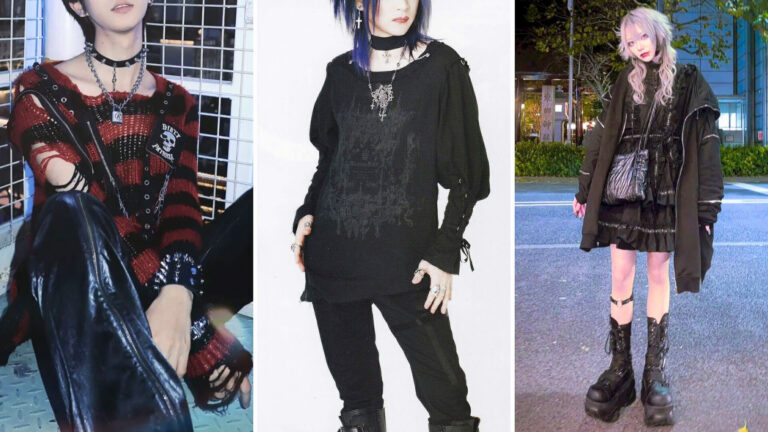
Visual Kei clothing encompasses a wide variety of styles, patterns, and colors, reflecting the eclectic and rebellious nature of the visual kei aesthetic. Some popular patterns in Visual Kei clothing include checkered, plaid, stripes, and the iconic “bandage” pattern. These patterns are often combined with bold and bright colors, such as red, purple, or electric blue, to create eye-catching outfits.
Leather and bondage wear play a significant role in Visual Kei fashion, adding a sense of edginess and rebellion to the overall aesthetic. Many musicians and fans incorporate leather jackets, pants, or accessories into their outfits, symbolizing a sense of rock ‘n’ roll and punk-rooted fashion. Anime-inspired outfits are also prevalent in Visual Kei fashion, taking inspiration from Japanese pop culture and manga/anime characters. These outfits often feature eccentric and elaborate designs, incorporating vibrant colors and unique accessories.
Interestingly, some Visual Kei musicians also embrace Westernized clothing like suits and military uniforms. This fusion of styles creates a distinctive and diverse fashion movement within Visual Kei. Loose-fitting clothes are highly valued in this aesthetic, allowing for freedom of movement on stage and enabling musicians to express their emotions and energy fully. Additionally, mixing different fashion styles, such as incorporating elements of gothic aesthetics or lolita fashion, is encouraged within the Visual Kei aesthetic, further adding to its diverse and boundary-pushing nature.
You can find more Visual Kei clothing and accessories in our Visual Kei Outfits Collection.
Try our new Aesthetic Outfits AI to Try-on Clothes.
Visual Kei Accessories and Jewelry
Visual Kei fashion is known for its bold and attention-grabbing accessories and jewelry. Studded leather is a staple in the Visual Kei aesthetic, adding a rebellious and edgy vibe to outfits. Leather bracelets and cuffs adorned with metal studs are commonly worn, creating a fierce and rock ‘n’ roll look.
Oversized jewelry is also a popular choice in Visual Kei fashion. Necklaces with large pendants featuring intricate designs or bold symbols are often seen, drawing attention to the neckline and adding a dramatic touch to the overall look. Chunky bracelets, sometimes adorned with spikes or chains, further enhance the visual impact.
Imposing rings are another essential element of Visual Kei style. These rings are often oversized and can feature elaborate designs, such as skulls, crosses, or other symbols inspired by gothic aesthetics. They make a bold statement and add a sense of power and significance to the hands.
In Visual Kei fashion, accessories and jewelry play a crucial role in enhancing the overall look and reflecting the rebellious spirit of the genre. Studded leather, oversized jewelry, necklaces, bracelets, and imposing rings are just a few examples of the wide range of accessories found in the Visual Kei aesthetic, contributing to its unique and captivating style.
Visual Kei Makeup
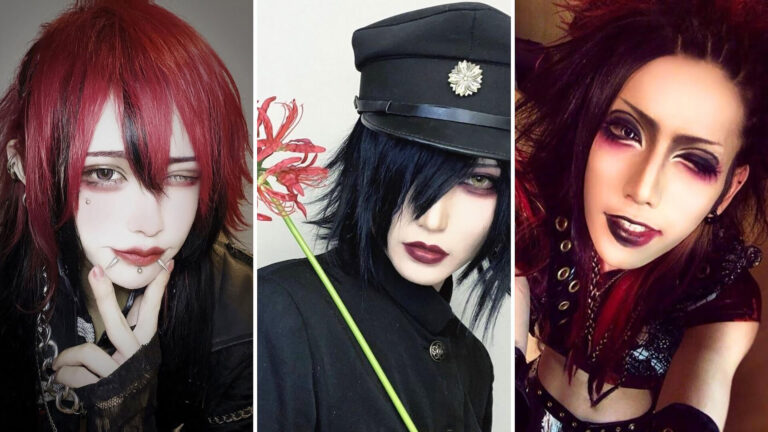
Visual Kei Makeup is an essential component of the overall Visual Kei aesthetic. Known for its bold and expressive nature, Visual Kei makeup plays a crucial role in creating the distinct look associated with this Japanese music and fashion movement.
One of the defining characteristics of Visual Kei Makeup is its dramatic and exaggerated style. Heavy makeup is used to create striking visual effects, often featuring bright colors, bold lines, and intricate designs. This expressive approach allows musicians and fans alike to make a statement and showcase their individuality.
Visual Kei Makeup also greatly influences the overall Visual Kei aesthetic. The intricate and elaborate makeup designs complement the wild and extravagant hairstyles, elaborate costumes, and the theatrical performances that are characteristic of Visual Kei music and fashion.
Furthermore, Visual Kei Makeup draws inspiration from various sources, including glam rock, gothic aesthetics, and even traditional Japanese fashions like Lolita fashion. As a result, the makeup creates a fusion of different styles and influences, making it a unique and visually impressive component of the Visual Kei aesthetic.
Visual Kei Hairstyles
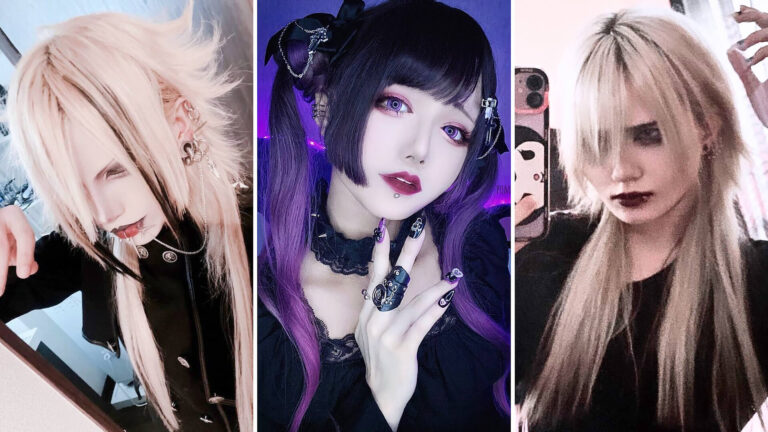
Visual Kei Hairstyles play a vital role in defining the visual aesthetics of the genre. They encompass a wide variety of looks, allowing individuals to express their unique style and personality. For a more androgynous appearance, long locks are often paired with feminine dresses, blurring the boundaries between masculine and feminine. This blend creates a visually striking and gender-fluid image.
On the other hand, spiked hair is a popular choice for those looking to embrace a punk image within the Visual Kei movement. This wild and rebellious style perfectly complements the edgy and unconventional nature of the aesthetic.
Dyed hair is another key element in Visual Kei Hairstyles. It allows individuals to make bold fashion statements and further enhance their visual identity. Popular colors among Visual Kei enthusiasts include silver, black, dark brown, and even neon shades. These vibrant and unconventional colors contribute to the overall dynamism and creativity of the look.
To add even more flair to the hairstyle, various hair accessories can be incorporated. Chains, clips, and hair ties are commonly seen in Visual Kei Hairstyles. These accessories help to accentuate the unique and intricate nature of the aesthetic, reinforcing its rebellious and unconventional spirit.
Visual Kei Nails and Nail Art
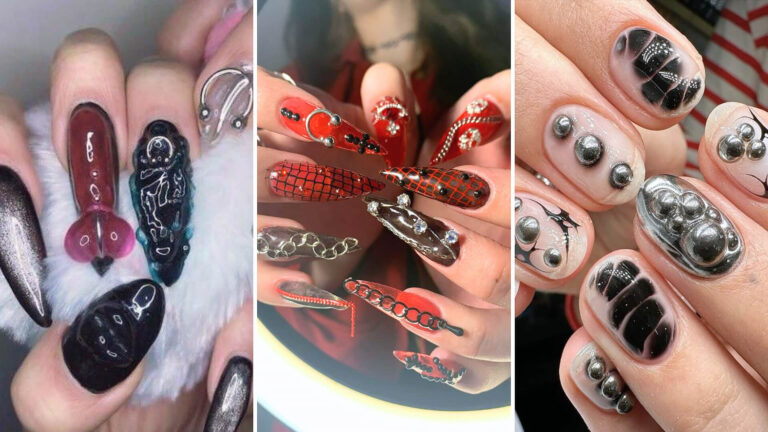
Visual Kei nails have become a popular form of self-expression within the Visual Kei aesthetic. With its bold and experimental nature, Visual Kei has influenced the world of nail art, allowing individuals to further enhance their visual identity through unique and intricate designs.
One of the common nail art styles associated with Visual Kei is the use of geometric patterns. This style often features bold lines, triangles, squares, and other geometric shapes, creating a visually striking and edgy look. Metallic accents are also commonly incorporated into Visual Kei nail art, adding a touch of glamour and rockstar aesthetic.
Bold and vibrant colors are a staple in Visual Kei-inspired nail art. Shades like neon pink, electric blue, and fiery red are often used to create eye-catching designs that grab attention. These colors perfectly complement the overall dynamism and creativity of the Visual Kei aesthetic.
In addition to patterns and colors, Visual Kei enthusiasts often incorporate motifs into their nail art designs. Music notes, band logos, or other symbols associated with their favorite bands or the Visual Kei movement itself can be etched onto the nails. This allows individuals to showcase their love for music and express their support for the underground music scene.
Tips on How to Create Your Visual Kei Outfit
When creating a Visual Kei outfit, there are a few important tips to keep in mind to achieve that edgy and eye-catching look. Start by choosing dark colors as the base of your outfit. Black, deep purple, and dark brown are commonly used in Visual Kei fashion.
Incorporate popular patterns such as plaid and stripes into your outfit. These patterns add visual interest and reflect the punk rock influence in Visual Kei. Don’t be afraid to mix and match different patterns for a more unique and dynamic look.
Consider adding bondage wear and leather elements to your outfit. These elements add a rebellious and alternative flair to your style, which is a key component of Visual Kei aesthetic.
Experiment with different styles to make your outfit stand out. Combine elements of gothic, punk, and rock fashion to create a look that represents your personal style and creativity.
Emphasize the use of accessories to complete your Visual Kei outfit. Spiked chokers, studded belts, and chunky bracelets are popular choices. These accessories add an extra dose of attitude and glamour.
Choose appropriate shoes such as chunky boots, platform sneakers, or studded heels to complement your outfit. These shoe styles are both fashionable and comfortable for a full day of rocking out.
Finally, don’t forget to style your hair in a way that matches the Visual Kei aesthetic. Wild, spiky hair or colorful hair clips are great choices to express your individuality and enhance your overall look.
Follow these tips, unleash your creativity, and step into the world of Visual Kei fashion with confidence.
Impact of the Visual Kei Aesthetic on Fashion
The Visual Kei aesthetic has had a significant impact on fashion trends, both in Japanese culture and internationally. This unique style has influenced and shaped the way we perceive fashion, challenging traditional norms and embracing bold and theatrical elements.
Visual Kei, which emerged from the Japanese music scene in the 1980s, combines elements of glam rock, punk, and gothic aesthetics. It is characterized by its androgynous aesthetic, heavy makeup, and extravagant hairstyles. Visual Kei artists such as Luna Sea, Malice Mizer, and Psychedelic Violence Crime have popularized this style within the Japanese music industry.
Internationally, Visual Kei has been incorporated into mainstream fashion, with its influence seen in various aspects of the industry. Japanese fashion movements like Oshare Kei and Angura Kei have taken inspiration from Visual Kei, incorporating its wild hair, vibrant colors, and heavy use of accessories into their designs.
Furthermore, the Visual Kei aesthetic has challenged traditional gender norms by embracing elements typically associated with both masculine and feminine styles. This has allowed individuals to express their individuality and creativity through fashion, breaking free from societal expectations.
Visual Kei in Music and Entertainment
Visual Kei is a captivating movement that has made a significant impact in the music and entertainment industry. Emerging in the 1980s, Visual Kei transformed the Japanese music scene with its unique blend of musical styles and visually captivating performances.
Pioneering bands such as X Japan, Dir En Grey, Luna Sea, the GazettE, and Malice Mizer played a key role in defining the Visual Kei genre. X Japan, with their flamboyant and theatrical performances, was at the forefront of the movement, incorporating elements of glam rock and heavy metal into their music. Dir En Grey pushed the boundaries further with their dark and aggressive sound, captivating audiences with their raw energy and intense performances. Luna Sea, with their melodic and emotional music, gained popularity not only in Japan but also internationally.
The GazettE and Malice Mizer continued to push the genre’s boundaries with their visually stunning music videos and distinct musical styles. Their unique blend of heavy rock, gothic aesthetics, and captivating stage presence resonated with fans worldwide.
Visual Kei’s visually captivating performances, innovative music styles, and the passionate dedication of its artists and fans have made it a force to be reckoned with in the music and entertainment industry. Its influence has spread far beyond Japan, with Visual Kei bands gaining international recognition and a dedicated global fanbase.
Today, Visual Kei continues to captivate audiences with its bold and dynamic performances, proving that its impact in the music and entertainment industry is here to stay.
Future of the Visual Kei Aesthetic Beyond 2024
The Visual Kei aesthetic is poised for an exciting future beyond 2024, where we can expect to see a fusion of new trends, developments, and cultural shifts. As technology continues to evolve, it will undoubtedly have a significant impact on the Visual Kei movement. We can anticipate the inclusion of more digital elements and visual effects in live performances and music videos, creating a more immersive and visually stunning experience for fans.
Global connectivity will also play a crucial role in shaping the future of Visual Kei. With the advent of social media and streaming platforms, artists from Japan will have increased opportunities to connect with international audiences and collaborate with musicians from different cultural backgrounds. This will lead to a broader range of influences and musical styles incorporated into the Visual Kei aesthetic, making it a truly global phenomenon.
Fashion trends will also influence the evolution of Visual Kei. As fashion industries continue to change and adapt, we may see the emergence of new sub-genres within the Visual Kei movement, exploring different aesthetics and experimenting with different styles. The Visual Kei aesthetic might blend with other subcultures or take inspiration from current fashion movements, creating a fresh and dynamic visual style that keeps up with the times.
In summary, the future of the Visual Kei aesthetic beyond 2024 promises to be a blend of technological advancements, global connectivity, and evolving fashion trends. It will continue to captivate audiences both in Japan and around the world, pushing boundaries and creating new trends in the ever-changing landscape of music and visual aesthetics.
